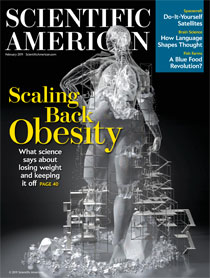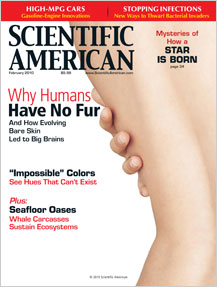Before you say something is out of this world, first make sure that it is not in this world
SIR ARTHUR CONAN DOYLE was the brilliant author of the wildly popular Sherlock Holmes detective stories, which celebrated the triumph of reason and logic over superstition and magical thinking. Unfortunately, the Scottish physician-turned-writer did not apply his creation’s cognitive skills when it came to the blossoming spiritualism movement of the early 1900s: he fell blindly for the crude hoax of the Cottingley Fairies (read about it in Junior Skeptic issue 36) photographs and regularly attended séances to make contact with family members who had died in the First World War, especially his son Kingsley. Perhaps fittingly, Conan Doyle’s fame brought him into company with the greatest magician of his age, Harry Houdini, who did not suffer fakes gladly.
In the spring of 1922 Conan Doyle visited Houdini in his New York City home, whereupon the magician set out to demonstrate that slate writing — a favorite method among mediums for receiving messages from the dead, who allegedly moved a piece of chalk across a slate — could be done by perfectly prosaic means. Houdini had Conan Doyle hang a slate from anywhere in the room so that it was free to swing in space. He presented the author with four cork balls, asking him to pick one and cut it open to prove that it had not been altered. He then had Conan Doyle pick another ball and dip it into a well of white ink. While it was soaking, Houdini asked his visitor to go down the street in any direction, take out a piece of paper and pencil, write a question or a sentence, put it back in his pocket and return to the house. Conan Doyle complied, scribbling, “Mene, mene, tekel, upharsin,” a riddle from the Bible’s Book of Daniel, meaning, “It has been counted and counted, weighed and divided.” (continue reading…)
read or write comments (2)
How a lack of control leads to superstition
and what can be done about it
Imagine a time in your life when you felt out of control—anything from getting lost to losing a job. Now look at the Figure 1 on this page. What do you see? Such a scenario was presented to subjects in a 2008 experiment by Jennifer Whitson of the University of Texas at Austin and her colleague Adam Galinsky of Northwestern University . Their study, entitled “Lacking Control Increases Illusory Pattern Perception,” was published in Science.
Defining “illusory pattern perception” (what I call “patternicity”) as “the identification of a coherent and meaningful interrelationship among a set of random or unrelated stimuli … (such as the tendency to perceive false correlations, see imaginary figures, form superstitious rituals, and embrace conspiracy beliefs, among others),” the researchers’ thesis was that “when individuals are unable to gain a sense of control objectively, they will try to gain it perceptually.” As Whitson explained the psychology to me, “Feelings of control are essential for our well-being—we think clearer and make better decisions when we feel we are in control. Lacking control is highly aversive, so we instinctively seek out patterns to regain control—even if those patterns are illusory.” (continue reading…)
read or write comments (8)
I don’t think religious beliefs are different from any other kind of beliefs: political attitudes, commitments to political parties, or economic ideologies, for example. These are all forms of belief. I think at the base of it is this whole idea that we’re pattern-seeking primates. We connect the dots — A connects to B connects to C — and often, they really are connected, and that’s called associative learning. All animals do it. It’s a biological imperative; we grow new synaptic connections when we learn something.
The problem is that there’s no baloney detection module in the brain that says, “That’s a true pattern; that’s a false pattern” with some consistent algorithm that helps us discriminate those. We tend to assume all patterns are real and that they’re infused with intentional agency. And that’s where I think the belief in spirits and ghosts and souls and gods and God and conspiracy theories and so forth comes in. (continue reading…)
read or write comments (17)
A review of SuperSense: From Superstition to Religion—the Brain Science of Belief by Bruce M. Hood. This review was published in the Science magazine on June 12, 2009.
During a recent trip to Austin, Texas, for a debate with Old Earth creationists, I paid a visit to Lance Armstrong’s famous bike shop Mellow Johnny’s (so named because Americans butcher the pronunciation of maille jaune, French for yellow jersey). In addition to numerous yellow jerseys hanging on the walls, on the showroom floor were several of the bikes that Armstrong rode while winning seven Tours de France. “People think these are replica bikes,” the shop manager told me. “When I explain that these are the actual bikes on which Lance won the tour, they touch them like holy relics.”
Why people imbue physical artifacts with an almost mystical force that can transmit its power to the contactee is the subject of Bruce M. Hood’s marvelous new book, SuperSense: Why We Believe in the Unbelievable. In an account chock full of real-world examples reinforced by experimental research, Hood (a cognitive psychologist at the University of Bristol) builds a theoretical model to explain how the mind comes to sense that there is something beyond the natural world, something supernatural. He calls this phenomenon our “supersense.” Our supersense underlies our tendency to believe that objects, animals, and people contain an essence (something at the core of their being that makes them what they are) and that this essence may be transmitted from objects to people and from people to people. There may be evolutionary reasons for this tendency, rooted in fears about diseases and contagions that contain all-too-natural essences that can be deadly (and hence should be avoided). But we now generalize the supersense to any and all objects, seen and unseen, and assume that those seen and unseen objects have agency and intention.
The supersense is not restricted to the uneducated or unintelligent. “Many highly educated and intelligent individuals experience a powerful sense that there are patterns, forces, energies, and entities operating in the world that are denied by science because they go beyond the boundaries of natural phenomena we currently understand,” Hood notes. “More importantly, such experiences are not substantiated by a body of reliable evidence, which is why they are supernatural and unscientific. The inclination or sense that they may be real is our supersense.”
In other words, even smart people believe weird things. Why? I have argued that it is because we all have to believe things—whether they are weird things or nonweird things1. The process by which we come to believe things is called learning. We connect A to B to C, and often A really is connected to B, and B really is connected to C. But we do not have a falsepattern- detection device in our brains to help us discriminate between valid and misleading patterns, and so we make errors in our thinking: type I errors in believing patterns are real when they are not (false positives) and type II errors in not believing patterns are real when they are (false negatives). Imagine that you are a hominid on the plains of Africa and you hear a rustle in the grass. Is that the sound of a dangerous predator or just the wind? If you assume it is a dangerous predator and it is just the wind, you have made a type I error, but to no harm. But if you believe the rustle in the grass is just the wind when it is actually a dangerous predator, there is a good chance you’ll be removed from your species’ gene pool. Thus, I argued, there would have been natural selection for those hominids who tended to believe that all patterns are real and potentially dangerous. I called the resulting processes patternicity (the tendency to find meaningful patterns in random noise) and agenticity (the tendency to believe that the world is controlled by invisible intentional agents who may mean us harm)2, 3.
Hood’s supersense is a superstructure that incorporates both of these processes. It is the basis of superstition and magical thinking. “If essences are thought to be transferable, we will not consider ourselves isolated individuals but rather members of a tribe potentially joined to each other through beliefs in supernatural connectedness,” Hood explains. “We will see others in terms of the properties that make them essentially different from us. Such an idea suggests that some essential qualities are more likely to be transmitted than others.” He includes among these qualities “youth, energy, beauty, temperament, strength, and even sexual preference.” Many transplant patients suspect that certain aspects of the personality of the donor will be incorporated into their own essence. Along with hoping that some object will convey the force of good, we fear the transmission of evil. Studies discussed by Hood show, for example, that most people say that they would never wear the sweater of a murderer. The possibility fills them with disgust, probably an evolved emotion selected to avoid rotting food and disease-carrying substances. They would, however, happily wear the cardigan sweater of the children’s television host Mr. Rogers, which they believe makes them better persons.
The supersense is so powerful, in fact, that it can influence even the most rational of skeptics. At Mellow Johnny’s, I purchased an array of Lance Armstrong cycling gear (I ride bikes regularly). During my debate with the creationists that night, I was secretly wearing a pair of Lance Armstrong yellow-rimmed black socks and a “Livestrong” T-shirt underneath my suit. My rational brain does not for a moment believe that the essence of Armstrong’s celebrated strength and endurance powered me through the three-hour event. Yet, for some odd reason I felt more confident, and perhaps—given the influence of belief and the power of placebo—I was a better debater that night. I don’t know. But Hood knows that the supersense is all pervasive. For that reason, his book is an important contribution to the psychological literature that is revealing the actuality of our very irrational human nature.
References
-
M. Shermer, Why People Believe Weird Things (Henry Holt, New York, 1997).
-
M. Shermer, Sci. Am. 299 (6), 46 (2008).
-
M. Shermer, Sci. Am. 300 (6), 36 (2009).
Comments Off on Mr. Armstrong’s Jersey and Mr. Rogers’s Sweater
I am optimistic that science is winning out over magic and superstition. That may seem irrational, given the data from pollsters on what people believe. For example, a 2005 Pew Research Center poll found that 42 percent of Americans believe that “living things have existed in their present form since the beginning of time.” The situation is even worse when we examine other superstitions, such as these percentages of belief published in a 2002 National Science Foundation study: (continue reading…)
read or write comments (7)



